Mercury Cyclone Spoiler II

General History
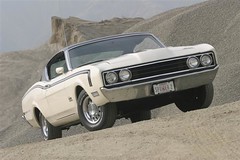 It was 1969. The Stones, “Honky Tonk Woman” was one of the top ten songs along with “Get Back,” by The Beatles and “Sugar, Sugar,” by the Archies. Richard Nixon was President, a house could be bought for $40,000.00. Milk was $1.26 and gas 36 cents a gallon! A postage stamp cost $0.06 and the average income was $8,547.00. (Were those the days, or what!)
It was 1969. The Stones, “Honky Tonk Woman” was one of the top ten songs along with “Get Back,” by The Beatles and “Sugar, Sugar,” by the Archies. Richard Nixon was President, a house could be bought for $40,000.00. Milk was $1.26 and gas 36 cents a gallon! A postage stamp cost $0.06 and the average income was $8,547.00. (Were those the days, or what!)
Ford and Mercury were racing in NASCAR and wanted to win more races. Unlike today, in 1969 NASCAR meant race cars were Stock Cars! They were all built from cars straight off the show room floor or their counterparts. 1969 was the time of AERO WARS on the high speed NASCAR tracks. The factories were in to manufacturing some pretty wild cars just to win on Sunday and sell on Monday. It also meant that if the manufacturer wanted to race it, they had to build it and sell it to the public. This resulted in the Ford Talladega, Dodge Daytona, Plymouth Super Bird and the Mercury Cyclone Spoiler II. NASCAR mandated that at least 500 of each car be manufactured to qualify for racing.
The big winged Dodge Daytona and Plymouth Superbird are arguably the most famous of the aero cars that raced in NASCAR but were they the first? NO!
The 1969 Ford Talladega and Mercury Cyclone Spoiler II were the Blue Oval’s designation for cars with the extended sheet metal on the nose. On this site we focus on the Ford cars and on this page we will cover the Mercury Cyclone Spoiler II.
Mercury Spoiler II
To build 500 such cars was a tall order for Mercury; each Cyclone Spoiler II had 19.5 inches of new sheet metal added to the front of the car. The entire front end was cut off just In front of the front tires and an entirely new, sloped nose was grafted to the original fenders. These cars were all built on an assembley line. The fenders were first modified and additional assembly materials constructed for final assembley in the factory. Many believe the Ford Talladega and the Mercury Cyclone Spoiler II are identical. In fact the Talladega had only 15.5 inches added to its nose. The Spoiler II’s nose is not only longer it is also built at a steeper 35-degrees vs the Talladega’s 30-degrees. At high speeds these differences actually made the Spoiler II from 2 to 8 mph faster than the Talladega. Most also believe the Talladega and Spoiler II have identical bodies, this also is not true. The only shared components between the cars are their doors, bumpers, grilles, and turn signals!
This is a Spoiler II fender with all of the paint removed. You can see the original seams where the factory fenders were cut and the new sheet metal added.
Thanks to Wayne Perkins for this excellent photo of his Spoiler II under restoration.
This is an original Spoiler II with the seam marked with blue tape. The metal to the left is the new aero metal. Notice how close the bumper sits to the fender compared to the standard production model.
This is a restored Spoiler with the correct “W” nose fender. The blue tape marks the location where the factory cut the original fender to add the new aero metal. Also note that the side marker light is moved forward on the Spoiler II.
As point of comparison this is a Ford Talladega with the seam marked with blue tape. The extended nose is in front of the tape.
This is a full view of the Spoiler II’s extended fender.
As stated earlier, NASCAR mandated that at least 500 of these hand built extended nose cars had to be manufactured. According to some rumors Mercury built only 351 out of a reported 503 units. How could they have done this? As the story goes they built 351 extended “D” nosed cars; parked them in the front and on the edges of a parking lot; took 152 regular “W” nosed Cyclone Spoilers and parked them in the middle of all the Spoiler IIs in the parking lot. When NASCAR counted the cars they just never looked closely enough at the cars in the rear! However, it must be known that the Marti Report states that 503 Spoiler IIs were manufactured.
Can you see the “W” in the nose of the standard factory Cyclone? Note that the hood is the end of the front end.
Now look at this Spoiler II with the extended nose; call the “D” nose or “long nose”. The panel in front of the hood was custom built and added by the factory. The blue line represents were the old sheet metal was cut off and the new aero metal added by the factory.
Note how similar this Talladega front end appears to be to the Spoiler II. In fact they are distinctly different and share no sheet metal between them.
This is a photo of the Cale Yarborough Spoiler II NASCAR race car.
Mercury built two versions of both the Spoiler (W nose) and Spoiler II (long nose) one was a Dan Gurney Special and the other a Cale Yarborough Special.
The Gurney Special is Blue and White while the Yarborough Special is Red and White.
Only the Spoiler had a scoop and hood pins. No Spoiler II should have scoop or hood pins. They were never available on these cars.
Both the Spoiler and Spoiler II should have a rear wing. However, these were dealer installed and some were never installed. Most were painted in a non-gloss black but a very few Gurney cars have been documented to have Blue Spoilers when new. It is unknown if they were painted at the factory or by the dealer. Finding a Spoiler or Spoiler II without a rear wing or “name” decals on the side does not mean it isn’t a real Spoiler or Spoiler II.
Here is the only correct wheel a Spoiler II.
Not how close the grill is to the front of the car on this Talladega, a Spoiler II should be the same.
On the Spoiler you can easily see the gap between the grill and the bumper as well as how far back the grill sits. Also note how much shape the bumper has.
On the Talladega and the Spoiler II the grill is mounted flush with the front end and the small gap between the grill and the sheet metal is filled by a rubber gasket to seal off the air. This was to make the nose of the cars as aerodynamic as possible.
It is difficult to see due to the reflections in this Spoiler II bumper but look closely and you can see the modifications to the end and top of the bumper. Ford took a rear bumper, cut it into three pieces, reshaped it and filled in the openings on the ends and made a new front bumper for the Talladega and Spoiler II. These new front bumpers acted like a rudimentary spoiler for the front end.
This is a photo of the rear bumper, you can see the cut out for the fender extension that had to be filled to make it a front bumper.
One critical changes to the Spoiler II that many observers never notice is the modification to the rocker panels. They were re-rolled to provide a shallower rocker panel. To determine how low a car could be for the race track inspection process NASCAR measured the rocker panels from the bottom edge. Due to the re-rolled rocker panels these cars could now sit 1″ closer to the track. The cars now had a lower center of gravity that aided in better cornering.
Here is a very basic drawing of the cross section of a rocker panel. The dashed line is where the stock Cyclone panel would be and the solid line is the “re-rolled” Spoiler II rocker panel. You can also see why the excess metal at the bottom is now 1 and 3/4 inches long instead of only 3/4 inches as on the stock Cyclone.
One of the biggest yet least noticeable changes to the Spoiler II are the re-rolled rocker panels. The photo above shows the metal lip at the bottom edge of the rocker panel. On a stock Cyclone this will be approximately 3/4 of an inch. NASCAR had restrictions on how low these cars could be built for the race track. The officials measured the distance from the bottom of the rocker panel to the pavement to determine ride height. Ford re-rolled the rocker panels for the production Talladega and Spoiler II in order to legally lower the car on the track.
Look closely and you can see the lip on this Spoiler II is 1 and 3/4 inches; 1 inch more than the stock Torino or Cyclone. It is painted black in these photos. To get the car lower for the track this lip would simply be trimmed off and the race car could be 1 inch lower!
Talladegas and Spoiler IIs do not have identical body panels. Along with the obvious differences between a stock Cyclone and Torino the aero cars had completely different front end extensions. They do share the same grill and bumper, however the sheet metal is different. In fact the Spoiler II was reported to be from 2 too 8 mph faster on the Super Speedways than the Ford. Since Ford wanted to win the NASCAR Manufactures Championship with a Ford not a Mercury and the Ford was still faster than a Dodge the factory put most of its drivers in Fords and left only 2 Mercury Spoiler IIs on the track.
Because of the extended noses the Talladega and Spoiler II had to have inside hood releases. Ford went to the parts bin and pulled out this Lincoln part to do the job.


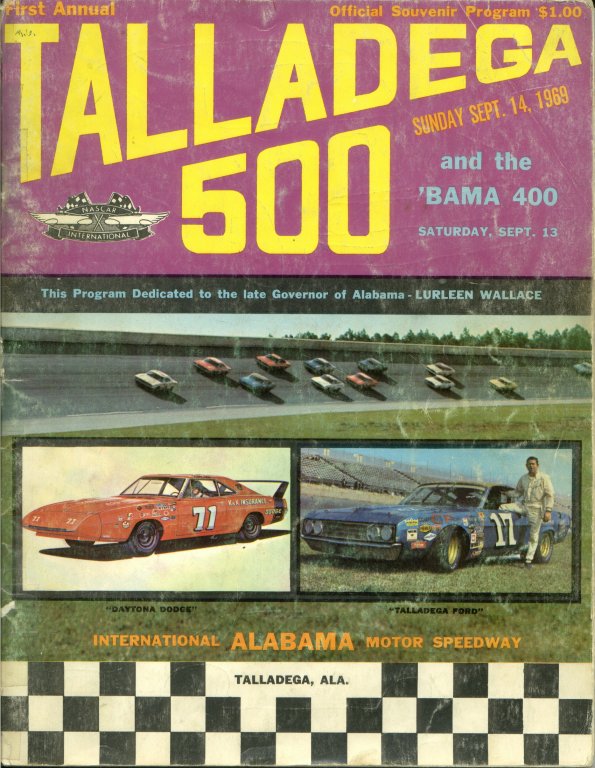
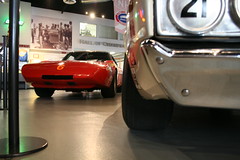
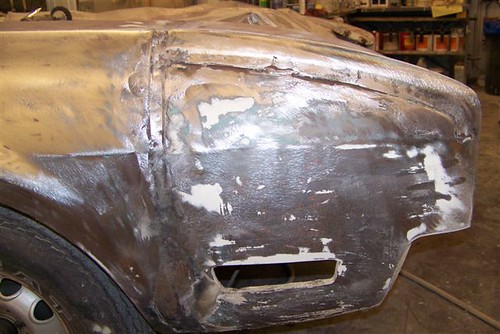
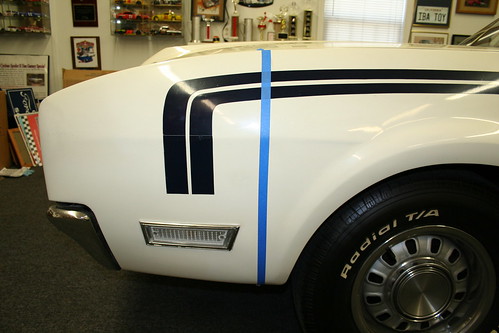
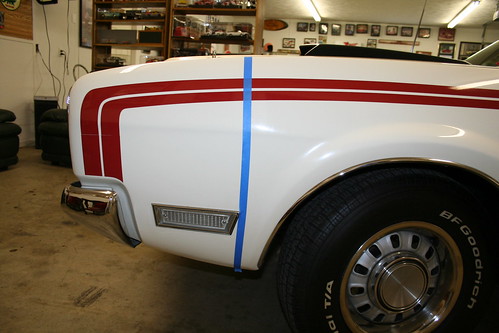
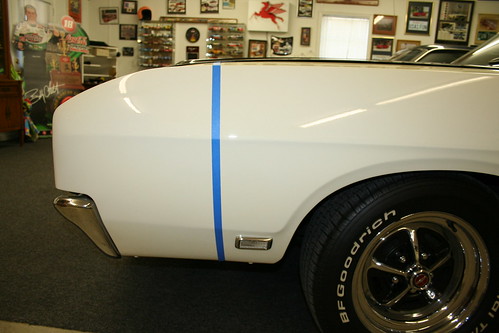
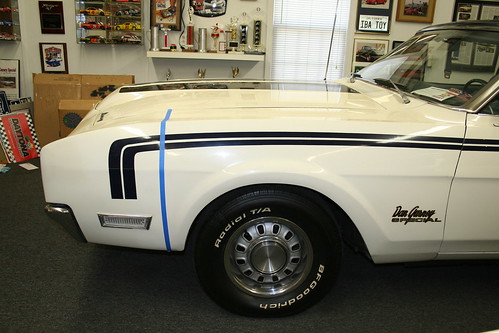

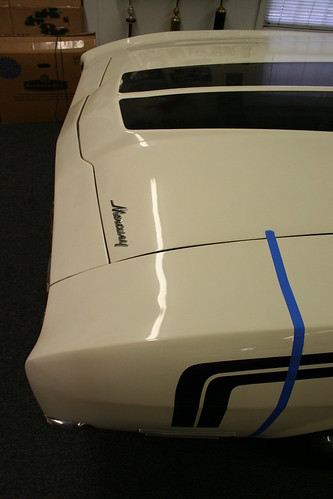
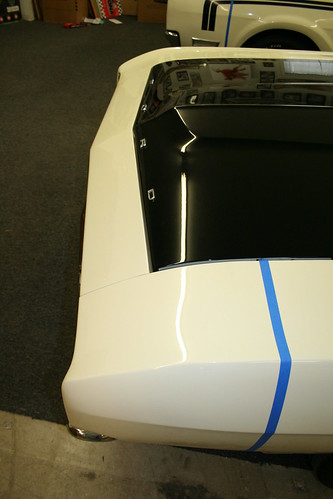
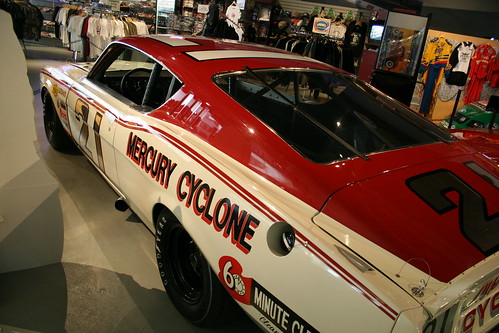

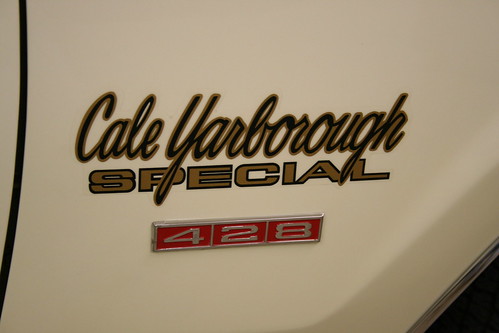

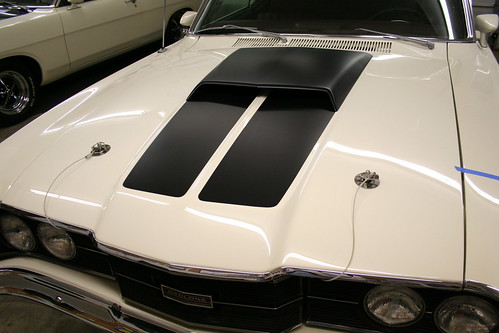
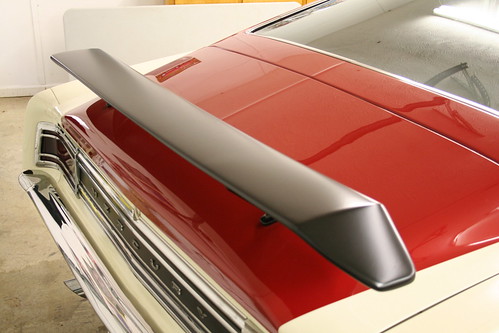

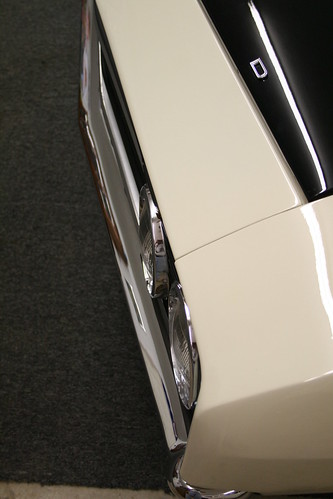

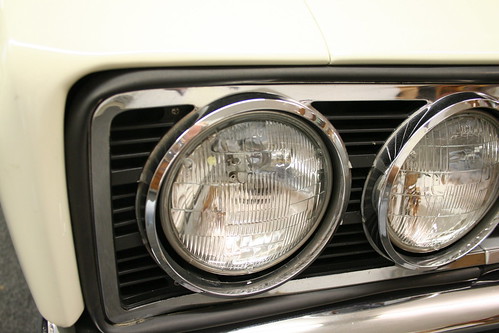

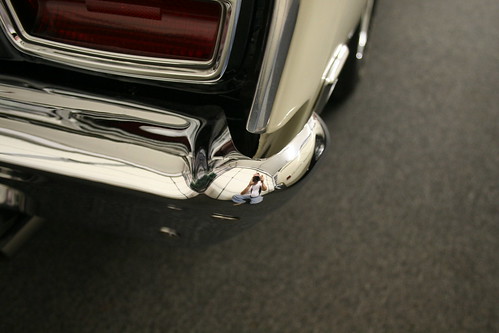
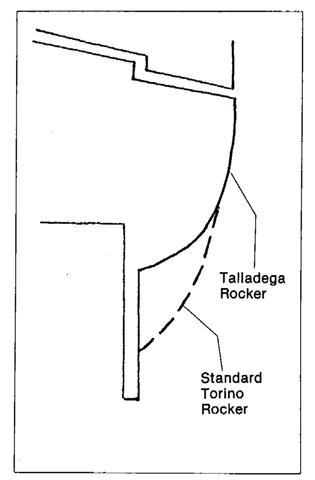
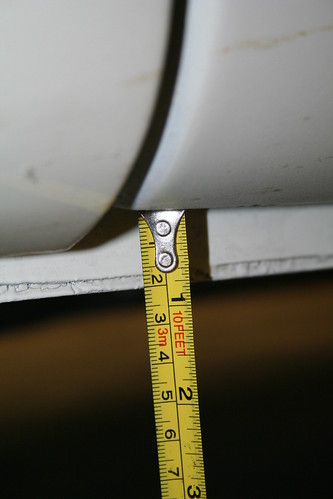
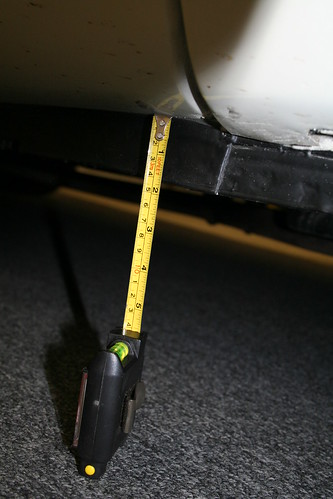
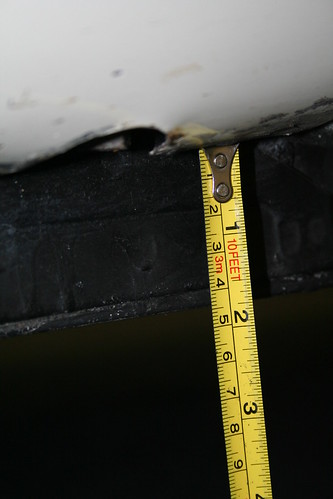
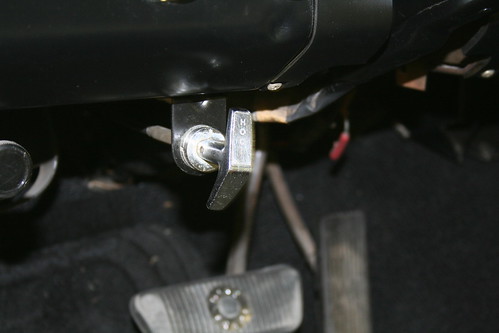
2 cents worth on the production numbers.
If you take the front end off of a Spoiler II & a std. Spoiler. You cannot tell them apart. You can read the door tags, the paperwork & anything else & not be able to tell the difference (aside from a DSO code & one having an inside hood release, optional on Cyclones??).
How hard would it be to add a std. flat hood, w/stipes, to a std. Spoiler? Wouldn’t the scooped hoods stand out w/all of the scoopless hoods?
Mercury made NO distinction between the two. They were all called Cyclone Spoiler. Consider, FOMOCO never made a Super Cobra Jet engine. They were all Cobra Jets w/the Drag Pac. WE call them Spoiler II or Super Cobra Jet.
So NASCAR is coming in a few days & your a little short on the long nosed Cyclone Spoiler. What to do?
Just a little food for thought.
Allen, sorry you are incorrect. You could park 50 Spoiler IIs and 50 Spoilers with no front ends on them and most of us could pick out the Spoiler IIs in seconds. The rocker panels are different on the Spoiler IIs. They are loke the Talladega and have been re-rolled to allow the race cars to be lowered an extra inch. Since there were no options on a Spoiler II any Spoiler with bucket seats or with any color interior other than blue or red or with bucket seats or any other option would have to be a Spoiler.
Now, as for the 428 SCJ Ford certainlu did build a Super Cobra Jet engine. It is not just what we call drag pack engines. Ask any Ford mechanic and they will tell you how a CJ and SCJ engine differ.
Thanks for visiting the site and giving us your comments.
better check your info. internals of the SCJ and the CJ had differences along with some minor exterior engine hardware.
This covers the bodies very well but didn’t one come only with the 351 and the other with the 428?
The Spoiler II was only available with the 351. The Spoiler came with the 351 but could be optioned up to any engine including the rare 428 SCJ with Ram Air!
Thank You to Richard and Marty Burke for doing the research on these cars and getting the facts correct. Rob
I’ve noticed that in the prints ads and brochures for ’70 Torino they never talk about a “Super Cobra Jet” with mechanical lifters and four bolt mains and 375hp at 5,600rpm – they only list the “ThunderJet” 360hp as standard on Cobra model, and then optional 370hp “Cobra” and then a “Cobra Jet” Ram Air with the same 370hp. Perhaps the SCJ was more like a mid year? Even in the Motor Trend car of the year issue they do not talk about a SCJ, but it does list a “Cobra Jet” of 370hp with ram air for the princely sum of $229 – above the cost of the Thunderjet. Cobra lists for $164 more, but that seems to have something to do with extra cost tires (perhaps the F60-15?). Seems like a lot for just the shaker hood. It shows the Drag Pack available on either CJ or Cobra – but apparently not Thunderjet. The 429 Thunderjet itself was only a $194 over the 302. Incidentally the Feb ’70 MT issue shows you could get the CJ on anything but a wagon.